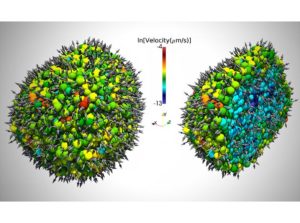
Using a computer simulation that models the physical and chemical interactions of cancerous cells (colored dots), researchers discovered that over time, tumors develop a distinctive two-part structure: slow moving cells moving randomly in a dense core (blue and purple), surrounded by a band of cells moving faster and more directly outward (green, yellow, red). Arrows indicate direction of motion. The image at right is the same tumor cut in half to reveal the inner structure.
Over a the University of Texas at Austin, Marc Airhart writes that researchers are using TACC supercomputers to better understand the physics behind the spread of cancer.
Scientists have recently discovered a method in cancer’s madness. Before now, they’ve been perplexed by how cancer cells, growing alongside healthy cells, often spread much faster into surrounding tissue than randomness would dictate. It’s as if cancerous cells are intentionally moving directly outward, invading healthy tissue. Scientists have struggled to explain this behavior from a biological perspective. Now a team of chemists and physicists from The University of Texas at Austin have used a computer simulation to explain, for the first time, the physics driving this motion.
The computer model simulated the early growth of a tumor, so what begins with 100 cancer cells results in 20,000 cells, corresponding roughly to about a week’s worth of growth for a cancerous tumor. The researchers designed the model to take into account things like the mechanical properties of cancer cells (their stiffness and how likely they are to stick to other cells) and their rates of birth and death.
The team discovered that when cancer cells have the ability to grow and divide much faster than they die, tumors tend to develop a unique spherelike structure with two distinct regions—a dense core of cells that don’t grow or divide much and an outer band of cells that grow and divide rapidly. Cells in the core don’t have much freedom to move because they are packed together like sardines in a can. Cells on the outside, with a firm foundation below them, are able to move quickly and efficiently outward, like a diver pushing off from a diving board.
Scientists observe this same kind of motion, called superdiffusion, in bubbles moving in foams. Before this study, researchers had no reason to believe that cancer cells would behave the same way.
The results appear online in the April 27 edition of the journal Physical Review X.
Having a physicist working on cancer can provide a new perspective into how a tumor evolves,” said Abdul Malmi-Kakkada, a postdoctoral researcher who led the project, along with postdoctoral researcher Xin Li, and professor and chair of chemistry Dave Thirumalai. “And rather than only looking at genetics or biology, trying to attack the problem of cancer from different perspectives can hopefully lead to a better understanding.”
The paper’s other author is Sumit Sinha, a graduate student in the Department of Physics.
This research was funded by the National Science Foundation.
Source: The University of Texas at Austin




